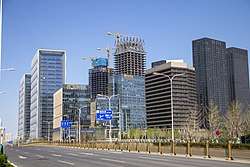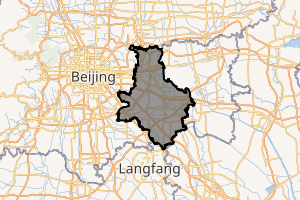Tongzhou District, Beijing
Tongzhou District (simplified Chinese: 通州区; traditional Chinese: 通州區; pinyin: Tōngzhōu Qū; Wade–Giles: T'ung1chou1 Ch'ü1, alternate spellings Tungchow Tungchou (T'ung-chou), or Tong County during 1914–1997) is a district of Beijing. It is located in southeast Beijing and considered the eastern gateway to the nation's capital. Downtown Tongzhou itself lies around 20 km (12 mi) east of central Beijing, at the northern end of the Grand Canal (on the junction between the Tonghui Canal and the Northern Canal) and at the easternmost end of Chang'an Avenue. The entire district covers an area of 906 km2 (350 sq mi), or 6% of Beijing's total area. It had a population of 673,952 at the 2000 Census, and has seen significant growth and development since then, growing to a population of 1,184,000 at the 2010 Census. The district is subdivided into four subdistricts, ten towns, and one ethnic township.
Tongzhou 通州区 Tungchow | |
|---|---|
District | |
 Canal Business District under construction | |

| |
 Location of Tongzhou District in Beijing | |
| Coordinates: 39°54′36″N 116°39′23″E | |
| Country | People's Republic of China |
| Municipality | Beijing |
| Township-level divisions | 4 subdistricts 10 towns 1 ethnic township |
| District seat | Zhongcang Subdistrict |
| Area | |
| • Total | 906 km2 (350 sq mi) |
| Elevation | 32 m (106 ft) |
| Population (2010) | |
| • Total | 1,184,000 |
| • Density | 1,300/km2 (3,400/sq mi) |
| Time zone | UTC+8 (China Standard) |
| Postal code | 101149 |
| Area code(s) | 0010 |
| Website | bjtzh.gov.cn/ |
| Tongzhou | |||||||||
|---|---|---|---|---|---|---|---|---|---|
 "Tongzhou", as written in Chinese | |||||||||
| Chinese | 通州 | ||||||||
| Postal | Tungchow | ||||||||
| |||||||||
| Tongxian (Tong County) | |||||||||
| Simplified Chinese | 通县 | ||||||||
| Traditional Chinese | 通縣 | ||||||||
| Postal | Tungchow | ||||||||
| |||||||||
History

Tongzhou was founded in 195 BC during the Western Han Dynasty under the name of Lu (路) County, although there is evidence for human settlement in the Neolithic. At the start of the Eastern Han Dynasty the character Lu by which it was known was altered by the addition of a water radical to become Lu (潞). In 1151 under the Jin dynasty Lu County was renamed Tongzhou, roughly meaning 'the place for passing through', in recognition of its importance as the land and water approach to Beijing.
Qing & Republican era
In July 1937, subsequent to the infamous Marco Polo Bridge Incident, Tongzhou became another site of determined Chinese resistance. In the Tongzhou Mutiny troops of the nominally Japanese-puppet East Hopei Army rebelled and came to the aid of hard-pressed Kuomintang troops, and attacked the Japanese garrison. In the fall of Tongzhou to the Nationalists, many civilians were murdered and abused as well as captured Japanese military personnel.
People's Republic
The place name changed to Tong County (simplified Chinese: 通县; traditional Chinese: 通縣; pinyin: Tōng Xiàn) when the area was placed under the new municipal region of Beijing in 1914. It again reverted to "Tongzhou" when the area was upgraded in 1997 to a district.
On 11 July 2015, Tongzhou became the second administrative seat of Beijing as a "sub-administrative center" for the municipality.[1] Numerous local government departments will be moved to Tongzhou to reduce crowding within the city center of Beijing.[2]
Economy
In 2017, the regional GDP of the district was 75.8 billion yuan,[3] with GDP per capita at 50.3 thousand yuan.
Geography and environment
.jpg)
Tongzhou District borders the Beijing districts of Shunyi, Chaoyang and Daxing, Wuqing District of Tianjin Municipality, and Langfang City (both the Sanhe City−Dachang County−Xianghe County exclave and Guangyang District) of Hebei province, and is 12 miles from Tiananmen Square and 10 miles from Beijing Capital International Airport.
Tongzhou is situated on the North China Plain with an average elevation of 20 meters (66 ft). Its climate belongs to the mild temperate zone, with distinct seasons including hot summers and freezing winters. Dust storms are common. It has an annual mean temperature of 11.3 °C (52.3 °F). and 620 mm (24 in) of rainfall. Several large rivers, among them the Wenyu, the Liangshui and Chaobai flow through the district.
Administrative divisions
Tongzhou District is divided into six subdistricts, ten towns, and one ethnic township. Two of the towns of which carry the "area" (地区) label.[4][5]
| Name | Chinese (S) | Hanyu Pinyin | Population (2010)[6] | Area (km2) |
|---|---|---|---|---|
| Zhongcang Subdistrict | 中仓街道 | Zhōngcāng Jiēdào | 57,550 | 6.50 |
| Xinhua Subdistrict | 新华街道 | Xīnhuá Jiēdào | 8,891 | 3.25 |
| Tongyun Subdistrict | 通运街道 | Tōngyùn Jiēdào | ||
| Beiyuan Subdistrict | 北苑街道 | Běiyuàn Jiēdào | 73,423 | 36.60 |
| Yuqiao Subdistrict | 玉桥街道 | Yùqiáo Jiēdào | 64,482 | 11.20 |
| Luyuan Subdistrict | 潞源街道 | Lùyuán Jiēdào | 72,611 | 144.00 |
| Lucheng town | 潞城镇 | Lùchéng Zhèn | ||
| Yongshun (town) Area | 永顺(镇)地区 | Yǒngshùn (Zhèn) Dìqū | 195,194 | 39.46 |
| Liyuan (town) Area | 梨园(镇)地区 | Líyuán (Zhèn) Dìqū | 140,520 | 24.87 |
| Songzhuang town | 宋庄镇 | Sòngzhuāng Zhèn | 104,143 | 116.00 |
| Zhangjiawan town | 张家湾镇 | Zhāngjiāwān Zhèn | 89,273 | 105.80 |
| Kuoxian town | 漷县镇 | Kuòxiàn Zhèn | 61,413 | 113.68 |
| Majuqiao town | 马驹桥镇 | Mǎjūqiáo Zhèn | 107,048 | 82.00 |
| Xiji town | 西集镇 | Xījí Zhèn | 43,244 | 95.29 |
| Taihu town | 台湖镇 | Táihú Zhèn | 99,039 | 82.50 |
| Yongledian town | 永乐店镇 | Yǒnglèdiàn Zhèn | 40,241 | 105.00 |
| Yujiawu Hui Ethnic Township | 于家务回族乡 | Yújiāwù Huízú Xiāng | 27,184 | 65.70 |
Transportation
.jpg)
Downtown Tongzhou is connected to downtown Beijing by Jingtong Expressway and Batong Line, Beijing Subway. Beijing's Fifth and Sixth Ring Road are roughly equidistant from Tongzhou's CBD. Highways lead to Shenyang, Harbin and Tianjin/Tanggu. A seventh ring road, a sixth subway line, a Beijing-Shanghai high-speed railway and a Beijing-Tianjin shuttle are under construction.
Metro
Tongzhou is currently served by four metro lines operated by Beijing Subway:




Suburban railway
Tongzhou is also served by two suburban railway lines:


Industry and tourism
There are seven industrial zones with a total area of 64 square kilometers (25 sq mi) in Tongzhou, focusing on manufacturing and high-tech industries. Downtown Tongzhou is earmarked for redevelopment into a comprehensive central business district with an emphasis on consumer retail. In agriculture, the district emphasizes on horticulture, fruit-farming, seed-growing and aquatics. The district government is currently promoting Tongzhou's position at the head of the Grand Canal to attract tourists to its Grand Canal Cultural Park.
The Songzhuang artists' village, where many Chinese contemporary artists live and work, is located in the Tongzhou District.[7] [8]
Canal Business District is under construction. Headquarters of Beijing branches of Central Government-owned Enterprises and Headquarters of Beijing Government-owned Enterprises will move to Tongzhou[9]. Canal Business District plans to develop industrial clusters of headquarters economy and wealth management.[10]
Gallery of the construction site of Canal Business District:
Education and health
Tongzhou has good education facilities including 113 kindergartens, 141 primary schools, 51 high schools and many adult education colleges. It also boasts the Beijing Materials Institute, Beijing University of Technology and the Beijing Institute of Music. Its hospitals include a specialist tuberculosis treatment center and a hospital specializing in traditional Chinese medicine.
Private schools include:
References
- 北京加快"行政副中心"建设 将聚焦通州. ifeng.com. iFeng (Phoenix Television). Retrieved 15 July 2015.
- Johnson, Ian (25 June 2015). "China Aims to Move Beijing Government Out of City's Crowded Core". The New York Times. Retrieved 3 November 2016.
- "Regional Yearbook of Beijing,2018"
- These towns are officially classified as subdistricts, but as they coincide with the area of the same name, they are commonly named "areas" (地区)
- 2011年统计用区划代码和城乡划分代码:通州区 (in Chinese). National Bureau of Statistics of the People's Republic of China. Archived from the original on 11 April 2013. Retrieved 7 January 2013.
- Census Office of the State Council of the People's Republic of China; Population and Employment Statistics Division of the National Bureau of Statistics of the People's Republic of China (2012). 中国2010人口普查分乡、镇、街道资料 (1 ed.). Beijing: China Statistics Print. ISBN 978-7-5037-6660-2.
-
"Branding Songzhuang". Studio 360:Made in China. 16 November 2007. External link in
|title=(help) - "SongZhuang Artists Community". Retrieved 28 November 2008.
- "北京城市副中心行政办公区二期加快建设--北京频道--人民网". bj.people.com.cn. 5 January 2020.
- 徐飞鹏 武红利 (9 December 2019). "蔡奇:建设一流的现代运河商务区-新华网". 北京日报.
External links
| Wikivoyage has a travel guide for Tongzhou. |
| Wikimedia Commons has media related to Tongzhou District. |












